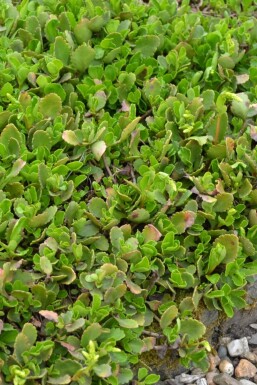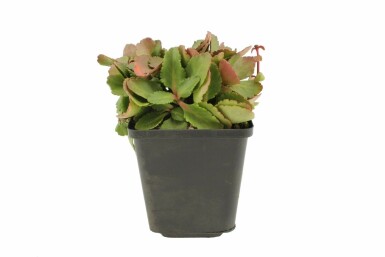

20cm



Updated on 10 September 2025
We regret to inform you that we are currently unable to ship orders to the United Kingdom. We anticipate being able to resume shipments at the beginning of 2026.
Chiastophyllum (gold drop) brings charm to the garden with its yellow blooms and succulent-like leaves. Ideal for rock gardens and walls, it thrives in shade and requires minimal care. Compact growth and drought tolerance make it perfect for low-maintenance spaces.


20cm



Chiastophyllum is a delightful addition to any garden, especially in shaded areas. This succulent boasts thick leaves and vibrant yellow flower clusters that gracefully hang from leaf rosettes. Blooming in late spring to summer, it brings a burst of colour to rock gardens and stone walls. Its cascading nature makes it perfect for covering rocky spots or hanging over edges, creating a stunning visual impact. Curious about how this shade-loving plant can transform your garden? Discover the charm and versatility of the Chiastophyllum plant, an ideal choice for cool, shady spots. Embrace the beauty of this yellow-flowering groundcover and explore options to buy Chiastophyllum in the UK for your alpine garden.
Chiastophyllum rupestre: Known for thriving on rocky outcrops, it provides a natural-looking addition to rockery gardens, blending seamlessly with its environment.Chiastophyllum is a wonderful choice for adding a unique touch to gardens. This succulent alpine plant is known for its distinctive appearance and vibrant yellow flowers.
Advantages:
Disadvantages:
Proper soil preparation, choosing the right planting location, and attentive care can minimise risks of diseases and pests. Ensuring good care will promote the best growth and flowering for Chiastophyllum (gold drop).
Chiastophyllum is perfect for those seeking ground cover in shaded spots or for adding interest in rock gardens and stone walls. Its compact growth makes it ideal for alpine planting and hanging over edges. This plant thrives in cool, shady areas, providing beautiful yellow blooms from May to July. It remains evergreen during mild winters, making it a reliable choice year-round.
One of the greatest advantages of Chiastophyllum is its drought-tolerance, requiring minimal maintenance while still offering attractive foliage and blooms. It's a semi-evergreen plant of alpine origin, known for its shade-tolerance. The gold drop effect of its blossoms adds a touch of brightness to any garden setting, ensuring a charming visual appeal.
For those in the UK looking to buy, consider Chiastophyllum for its suitability in various garden settings. It's an excellent option for those interested in succulents that thrive in cool, shady spots. Order Chiastophyllum from Heijnen and brighten your rock garden with yellow blooms and a charming growth habit.
Chiastophyllum, also known as gold drop, is a charming plant from the Crassulaceae family. This perennial, often called Lamb’s-tail or Yellow cascade, features small, fleshy leaves and produces striking yellow flowers. Its unique appearance makes it ideal for rockeries and alpine gardens. Originating from the Caucasus region, including Georgia, it thrives in cooler, shady spots which mimic its natural habitat. The gold drop is a popular choice for wall planting, serving as a vibrant groundcover or border edge. It is particularly suitable for low-maintenance gardens due to its slow-growing and hardy nature. Chiastophyllum's flowers attract bees, adding ecological value by supporting local pollinators. The name Chiastophyllum comes from the Greek words ‘chiastos’ meaning crossed, and ‘phyllon’ meaning leaf, symbolising its hidden beauty in alpine culture. As a shade-tolerant succulent alpine, it provides excellent coverage without the need for constant sunlight, making it a versatile option for UK gardens. For those looking to buy Chiastophyllum in the UK, it is available for purchase as a rockery succulent or pot plant. Its ability to thrive in cool shady areas makes it a perfect addition for gardeners seeking yellow-flowering groundcovers.
Chiastophyllum, also known as gold drop, is a perennial shade-loving plant with unique features. It’s a slow-growing succulent ground-cover perfect for rock gardens and wall planting. The Lamb’s-tail plant develops trailing forms and is well-suited for pots and planters. Its hardy nature makes it ideal for low-maintenance gardens. The growth of Chiastophyllum begins with thick, succulent leaves forming rosettes close to the ground. As it matures, it reaches a height of 10 cm to 30 cm, depending on the species and growing conditions. This plant thrives under semi-evergreen conditions, originating from alpine regions, reflecting its adaptability to shade and rocky terrains. Chiastophyllum blooms from May to July, producing hanging clusters of flowers. The sulphur yellow, light yellow, or soft yellow blooms appear from the leaf rosettes. Weather, climate, and proper care can affect the blooming time and intensity. A cool, shaded environment with well-drained soil enhances its flowering potential. The delicate blooms are complemented by the plant’s fresh scent, a subtle presence in the garden. The fragrance is enhanced when grown in proper soil conditions and maintained with adequate watering. In summary, Chiastophyllum is a ground-covering garden plant with succulent leaves and yellow blooms. Its size and form can vary, but its ability to fill garden spaces with colour and texture remains consistent. Suitable for shade-loving environments, it brings a charming touch to any garden.
Chiastophyllum is known for its fleshy, oval leaves that can have a blue-green to grey-green tint. These succulent-like leaves store moisture, making it an excellent choice for shady, lime-rich gardens. The plant is evergreen in mild winters, maintaining its leaves unless temperatures drop significantly. It is moderately hardy, surviving in USDA zones 6 to 8, and can withstand temperatures from -18°C to -12°C if planted in a sheltered location. Such conditions can affect its leaf retention during colder months. Chiastophyllum thrives in rockeries and prefers well-drained soil types, which helps it cope with varying conditions. The plant is heat and drought tolerant, thanks to its fleshy leaves and deep root system, which help conserve moisture. Wind protection is beneficial as excessive wind can affect its growth. Originating from rocky environments, it adapts well to dry conditions. Despite its exotic appearance, Chiastophyllum is not toxic to children or pets, ensuring it is safe for family gardens and flowerbeds. Furthermore, it enhances biodiversity by providing shelter and food for insects with its long-lasting yellow flower spikes from May to July. This flowering adds significant ecological value to gardens, supporting local wildlife and maintaining ecosystem balance.
Chiastophyllum, known for its vibrant yellow flowers, is a versatile plant that can transform any garden area. This succulent alpine plant thrives in various settings, offering a beautiful contrast with its silver and yellow hues.
Chiastophyllum is a hardy rock garden plant that pairs well with other ground covers. This plant is well-suited for shady areas and can create stunning displays when combined with other succulents and rock plants. Consider pairing Chiastophyllum with Sedum, a plant known for its resilience and vibrant foliage. The contrasting textures and colours can add visual interest to any garden. Saxifraga, with its delicate flowers, complements the yellow blooms of Chiastophyllum beautifully. Sempervivum, often called houseleeks, brings a unique rosette shape to the mix. Thymus, or thyme, offers a fragrant addition and attracts pollinators, enhancing the garden ecosystem. Dianthus adds a splash of colour with its bright flowers and pairs well in rock gardens. These combinations not only look beautiful but also thrive in similar locations, ensuring they grow well together. The low-growing nature of these plants means they can fill garden spaces without overwhelming each other, creating a balanced and harmonious garden design. Chiastophyllum (gold drop) with its yellow cascade is perfect for adding a touch of brightness to shaded areas.
Chiastophyllum prefers sunny to partially shaded spots. This plant thrives well with at least 4 to 6 hours of sun per day. It is important to consider that intense afternoon sun might be too harsh, so a balance with morning sunlight works best. When it comes to wind sensitivity, Chiastophyllum is quite resilient. However, if the location is particularly windy, consider using windbreaks like hedges or garden walls to protect it. The ideal soil for Chiastophyllum is rocky and humus-rich, similar to mountain slopes. This helps mimic its natural habitat and supports good growth. Ensuring the soil is well-drained promotes healthy root development. Regularly fertilising the soil and maintaining its quality will aid in the growth of this succulent alpine. In terms of moisture, Chiastophyllum prefers cool and moist conditions. While it can tolerate some shade and lime, keeping the soil slightly damp is crucial, especially if the location is sunny or windy. The pH preference for Chiastophyllum leans towards neutral to slightly acidic levels. Keeping these factors in mind will ensure a thriving yellow-flowering groundcover for the garden.
Chiastophyllum should be planted in spring or late summer, during times of cool weather for optimal growth. While plants delivered in pots can be planted year-round, those with roots or soil balls are best planted in spring or autumn. Suitable for rock gardens or stony borders, Chiastophyllum prefers an acidic, humus-rich soil to thrive. It's essential to add leaf mould to retain moisture in the soil. When considering plant spacing, factors such as plant type, initial size, and growth speed are important. It's advised to refer to product pages for specific planting details. For Chiastophyllum, known for its yellow blooms, the ideal spacing ensures adequate room for growth and airflow. Proper soil preparation is vital for Chiastophyllum. The soil should be well-drained yet slightly moist, using Heijnen planting soil for best results. Planting instructions for Chiastophyllum include regular watering post-planting and timely fertilisation. This ensures the plant establishes well in its new environment. Gold drop, or Chiastophyllum, is known for its fleshy leaves that store moisture. It prefers sunny to partially shaded spots, thriving with four to six hours of sunlight daily. It suits mountain slopes and rocky areas with cool, moist conditions, enhancing any garden with its vivid yellow charm.
Chiastophyllum, known as the gold drop, is an excellent choice for those seeking a low-maintenance plant. It thrives in rocky, well-drained soil and suits various garden uses, such as rock gardens and ground covers. The yellow cascade blooms from May to July, adding vibrant colour to the garden.
Chiastophyllum is a lovely plant with bright yellow flowers that appear in the summer. The flowers have a soft, cheerful yellow colour, making them a standout feature in the garden. Its leaves are similar to succulents, with a blue-green to grey-green colour, and they stay attractive all year round. The plant grows well in shaded rock areas and stone walls, offering a beautiful ground cover with its trailing nature. Chiastophyllum is also drought-tolerant, requiring little maintenance, which makes it perfect for busy gardeners. The foliage and blooms attract bees and other pollinators, making it an eco-friendly choice. The plant's compact growth provides texture and interest, particularly when cascading over rocks or hanging from stone walls. Chiastophyllum grows well among rocks and is a colourful rock plant. It serves as an excellent choice for alpine planting and works well as a yellow-flowering groundcover in shaded areas.
We would like to provide some tips on how to plant and care for a Chiastophyllum. By following these tips, you can be sure to enjoy your Chiastophyllum for a long time.
Chiastophyllum thrives in sunny to partially shaded locations, needing at least 4-6 hours of sunlight daily for optimal growth. This plant prefers rocky or humus-rich mountain slopes, where the cool and moist conditions support its development. The well-drained soil, enriched with lime, is essential for the fleshy leaves of Chiastophyllum, which store moisture, enhancing its resilience. Correct placement ensures better growth, richer blooms, and healthier foliage. The plant's vibrant yellow flowers are more pronounced with proper sun exposure. While Chiastophyllum adapts to various soil types, its preference is for fertile, well-drained conditions. It can grow in both moist and slightly dry soils, with species-specific variances in drainage needs. Chiastophyllum's versatility makes it ideal for rock gardens, wall planting, as groundcover in shaded areas, or in pots and planters. Selecting the right spot is crucial for its flourishing and visual appeal.
Preparing the soil is crucial when planting Chiastophyllum. Proper soil preparation ensures good growth by enhancing water drainage and providing nutrients. Mixing organic materials like compost or specific planting soil improves structure and nutrient content. It's important to work the soil before planting, as this allows for better root establishment. Chiastophyllum, known for its yellow flowers, should be planted in acidic, humus-rich, well-drained soil. Pot-grown plants can be planted year-round except during frost. For those with a burlap sack, plant with the sack intact in spring or autumn. After planting, watering is essential until roots are fully established. Ensure adequate space between plants based on their size. This attention to detail supports the plant's development, allowing it to thrive, especially in partially shaded areas.
Fertilising Chiastophyllum plants is vital for ensuring healthy growth and vibrant blooms. Regular fertilisation supports the plant's vitality, promoting lush leaves and strong, sulphur-yellow flowers. Using an organic fertiliser from Heijnen enhances plant health, providing essential nutrients for robust growth and rich flowering. Fertilise twice a year, once in spring and again in summer, to maintain plant vitality. The amount of fertiliser depends on plant size; larger plants require more nutrients. To ensure nutrient absorption, water the plants after applying fertiliser, especially in dry periods. This process helps nutrients reach the roots, fostering strong growth. Remember, over-fertilising should be avoided to keep the compact nature of the plant intact.
Chiastophyllum benefits from light pruning after it blooms. This keeps the plant compact and supports healthy growth. Regular pruning encourages more flowers and prevents overcrowding. It's best to prune gold drop in the spring, just after it finishes flowering. Doing this only once a year is enough to maintain its shape and health. Use sharp secateurs to carefully cut away any damaged or dead parts. Good tools make clean cuts, which are important for the plant's recovery. Remember to prune gently to avoid stress on the Chiastophyllum. Always ensure the soil is well-draining as this plant does not like winter moisture. Enjoy the vibrant blooms and help your Chiastophyllum thrive with a bit of care.
Chiastophyllum needs a moderately moist environment and benefits from extra watering during warm periods. Newly planted Chiastophyllum should receive regular watering to help establish roots. Once established, they only require water in prolonged dry spells. Providing a thorough watering is more effective than giving small amounts daily when the plant needs it. It's advisable to water the plant in the early morning or late evening to minimise evaporation. Always check the soil moisture to ensure water is necessary. Excess water must be able to drain away to prevent root rot, whether in open ground or pots. Drip irrigation systems work best once the Chiastophyllum is established; initially, watering should be done by hand. While Chiastophyllum tolerates drought better than other rockery plants, ensure it receives adequate water during extended dry periods. Plant roots need proper drainage for optimal growth.
Chiastophyllum is a captivating plant perfect for any garden with its vibrant yellow flowers and succulent-like foliage. Known for its compact growth, this plant thrives in wall and rock gardens and is drought-tolerant, making it low maintenance. The gold drop blooms add brightness to any space during summer. Its Greek name, meaning 'crossed leaf,' symbolises hidden beauty in alpine cultures. Safe for both children and pets, Chiastophyllum is a charming, reliable choice for plant lovers.
Chiastophyllum benefits from division to maintain vitality and encourage new growth. Dividing can rejuvenate the plant and remove old parts. This process allows for continuous growth and helps keep the garden looking vibrant. Dig up the plant carefully, ensuring that root-bearing growth points are separated. Plant the young sections back into the soil. It is recommended to divide every few years, ideally in autumn, as this timing supports recovery and establishment. Division also helps manage the plant's size. Ensure proper tools like a spade or sharp knife for clean cuts. Regular division of Chiastophyllum ensures healthy growth and continuous bloom of gold drop flowers.
Gold drop is a delightful succulent alpine known for its compact growth and trailing habit. Ideal for rock and wall gardens, this yellow-flowering groundcover is drought-tolerant and low maintenance. Its attractive foliage and blooms contribute to its appeal. Flowers bloom in shades of sulphur yellow, attracting bees and providing ground cover for shady walls. Buy Chiastophyllum (gold drop) from Heijnen to enhance your garden with its charming presence.
